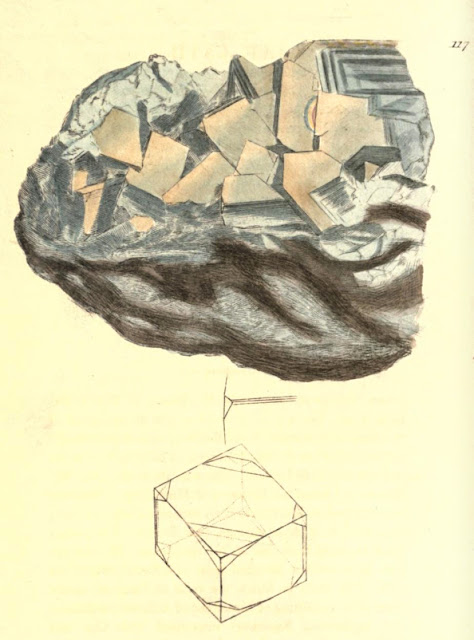1797 Discovery of Celestine near Bristol
I very much enjoy connecting J.C. Sowerby's early mineral illustrations and descriptions to actual specimens.
In Sowerby (1804), he illustrates a distinctive specimen of celestine, shown below, from Aust in Gloucestershire, near Bristol.
He reports that a Mr. Clayfield had discovered "Sulphate of Strontian" here in 1797. "He observes that he discovered detached veins in different parts of the cliff. The strata in which the veins are found are nearly horizontal, consisting of Limestone of different hardnesses, and argillaceous Sandstone intermixed with Clay and Gypsum, and some of the fissures were filled up with Sulphate of Strontian from 3 to 12 inches in thickness."
I have an old specimen (shown in the three photographs below) which shows the same crystal form and orange staining. The specimen is 9 cm long and displays crystals to 3 cm. The label states an origin from the nearby Yates mine, but the crystals do not seem to be typical of specimens from there. I do not know how much variability exists in celestine from the two localities.
Delightful functionality at smorph.nl allows this crystal form to be drawn. You simply chose your crystal forms and adjust the relative growth rates to achieve a match with the actual specimens.
Celestine crystals from the Yate locality that I have seen in museums (British Museum Natural History and the Sedgwick in Cambridge) are typically white and show prismatic forms.
In Sowerby (1804), he illustrates a distinctive specimen of celestine, shown below, from Aust in Gloucestershire, near Bristol.
He reports that a Mr. Clayfield had discovered "Sulphate of Strontian" here in 1797. "He observes that he discovered detached veins in different parts of the cliff. The strata in which the veins are found are nearly horizontal, consisting of Limestone of different hardnesses, and argillaceous Sandstone intermixed with Clay and Gypsum, and some of the fissures were filled up with Sulphate of Strontian from 3 to 12 inches in thickness."
I have an old specimen (shown in the three photographs below) which shows the same crystal form and orange staining. The specimen is 9 cm long and displays crystals to 3 cm. The label states an origin from the nearby Yates mine, but the crystals do not seem to be typical of specimens from there. I do not know how much variability exists in celestine from the two localities.
Drawing of the crystal form seen in the Gloucestershire specimen illustrated above.
Celestine crystals from the Yate locality that I have seen in museums (British Museum Natural History and the Sedgwick in Cambridge) are typically white and show prismatic forms.








Comments
Post a Comment